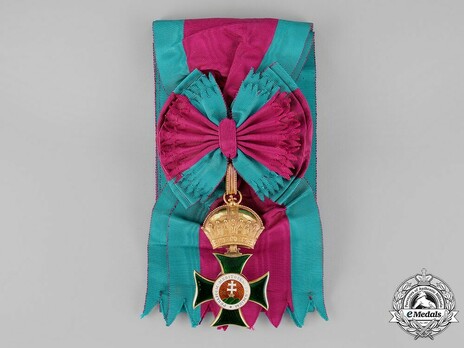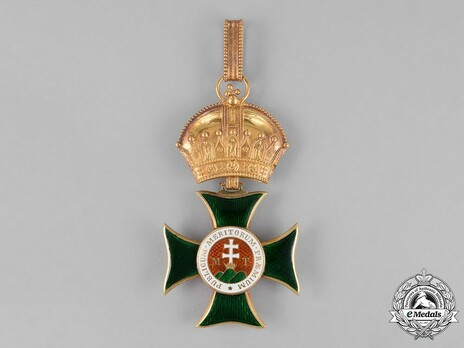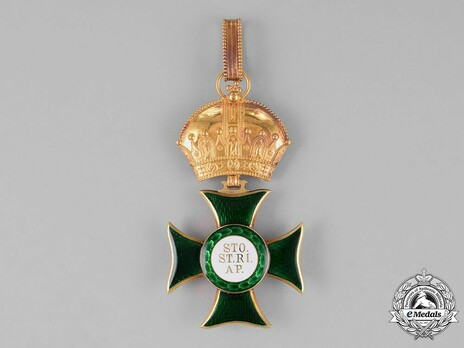Order of St. Stephen, Type II, Grand Cross
CATEGORY: Version
SKU: 01.AUT.0103.301.01.000
Estimated market value:



Estimated market value:
The Sash Badge constructed of Gold (hollow), with green enameled arms; the obverse with a central red enameled medallion depicting the Hungarian Double-Cross on a Gold crown placed at the top of three green enameled hills, flanked by the letters “MT” for “M aria Theresia”, surrounded by a broad ring of white enamels inscribed “PUBLICUM MERITORUM PRAEMIUM” (Latin - Public Award for Merit); the reverse with a white enameled central medallion, inscribed “STO. ST. RI. AP.” (Latin - To the Holy Apostolic King Stephan), surrounded by a green enameled ring in the shape of an oak wreath; suspended from a broad loop connected to a hollow Gold Hungarian crown, and a broad loop for suspension; marked “FR”, a Vienna Assay mark, and a “3-Goat Head-A” gold hallmark on the award, with “FR” and the same gold hallmark on the loop for the crown; on a period original ribbon sash for suspension; the badge measuring 48.69 mm (w) x 48.82 (h), and the crown measuring 40.61 mm (w) x 42.07 mm (h). Accompanied by the case of the ribbon sash; constructed of heavy red cardstock with a red faux leather (leatherette) exterior; the exterior of the lid embossed with a Hungarian crown, within elaborate arabesques; with a lined interior lid - marked with the maker mark of “C.F Rothe”, with a partially severed lid keepers, a spring catch and stud release, and a functional exterior metal hinge; measuring 128 mm (w) x 221 mm (h); in overall virtually mint condition.
This Order was established by Empress Maria Theresa of Austria to honour Hungarian nobility who had rendered substantial civil service.
Following years of war, Austria eventually entered a period of peace. Due to the creation of the Military Order of Maria Theresa specifically awarded to military officers, it was decided a civilian equivalent was necessary. Stephen I of the Arpad Dynasty the first King of Hungary (1000-1038), and therefore was also a patron saint. The Order was named after him for both political and religious reasons. In 1760, the idea of the Order was supported by Count France Esterhazy de Galantha and was legally approved by Maria Theresa in 1764. The official date of foundation was May 5, 1764, in line with the coronation ceremonies of Archduke Joseph being crowned King of the Romans.
The Order was awarded for extraordinary civil services to the ruling house and to the state (however, high ranking military officials were often awarded this Order). The Grand Master position was to be held by each successive Hungarian Monarch, the first being Maria Theresa, followed by Emperor Joseph II. It was awarded in three classes with a fixed number of companions: the Grand Cross (20), the Commander’s Cross (30) and the Knight’s Cross (50). A chain was presented to members of the Habsburgs lands, and depending on the other class of decoration, special ‘robes’ were awarded.
In 1908, a new field uniform was introduced which resulted in a new ruling regarding how the Grand Cross was worn. When an individual was in the field, on manoeuvres, for indoor duty and off duty, they would wear the Knight’s Cross with a reduced size (20mm) Grand Cross Star attached to a triangular ribbon. In 1918, this concept was applied to the Commander class as well. Although this order was specifically created for civilians, on March 18 1918, a “Grand Cross with war decoration and swords” was awarded to Archduke Joseph. This award is not documented elsewhere, so it is difficult to say whether this was a lavish act of the Archduke or Emperor Karl I, who awarded it. The Order of St. Stephen ceased to be awarded by the end of 1918.
In 1938, the Order of St. Stephen was revived by Regent Admiral Nikolaus Horthy de Nagybanya in the Kingdom of Hungary. It was awarded a few times and finally dissolved in 1944. However, in 2011 it was refounded and endowed in Hungary. It was awarded in 2013.
Recipients were required to return their decorations after death, however they could have privately made crosses manufactured. The main differences between the types is based on the style and construction of the crown and the quality of the medallion. Type I is early and is identified by the crown only having an obverse face. It is attached to the ribbon with a slide. This type lasted until the early 19th century, and the time period is therefore considered 1757 until around 1840. The Type II crown is attached to cross but is hollow. The reverse bears a single loop to feed the ribbon through. This time period is considered to be roughly 1840-1880. The Type III crown is embossed on both the obverse and the reverse, creating a three-dimensional crown. A ring, or eyelet was added to the orb on the top of the crown to allow a ribbon to be attached. These types are more widely seen, and are often considered to be from 1880-1918. In the early models, the order’s device was in black enamel on the obverse with the initials on the reverse. After 1860, the inscription was embossed in Gold. Moreover, the transition to metal stars was officially made in 1847.
Grand Cross recipients had to prove four generations of nobility, unless they were a count, baron or chambermaid. Between 1916-1918, 11 Grand Crosses were awarded each year under Emperor Karl I. This class was often awarded to foreign heads of states, ambassadors and ministers. From 1764 to 1918, a total of 876 Grand Crosses were award, and 50 of those were Grand Crosses with Diamonds.
See the Order of St. Stephen of Hungary, in the Orders of the Hungarian Regency (1918-1944), and the Hungarian Order of St. Stephen, in the Orders of Hungary (1989) for more information.

Comments
Sign in to comment and reply.


Scroll Top